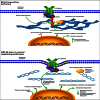EPLIN: a fundamental actin regulator in cancer metastasis?
- PMID: 26350886
- PMCID: PMC4661189
- DOI: 10.1007/s10555-015-9595-8
EPLIN: a fundamental actin regulator in cancer metastasis?
Abstract
Treatment of malignant disease is of paramount importance in modern medicine. In 2012, it was estimated that 162,000 people died from cancer in the UK which illustrates a fundamental problem. Traditional treatments for cancer have various drawbacks, and this creates a considerable need for specific, molecular targets to overcome cancer spread. Epithelial protein lost in neoplasm (EPLIN) is an actin-associated molecule which has been implicated in the development and progression of various cancers including breast, prostate, oesophageal and lung where EPLIN expression is frequently lost as the cancer progresses. EPLIN is important in the regulation of actin dynamics and has multiple associations at epithelial cells junctions. Thus, EPLIN loss in cancer may have significant effects on cancer cell migration and invasion, increasing metastatic potential. Overexpression of EPLIN has proved to be an effective tool for manipulating cancerous traits such as reducing cell growth and cell motility and rendering cells less invasive illustrating the therapeutic potential of EPLIN. Here, we review the current state of knowledge of EPLIN, highlighting EPLIN involvement in regulating cytoskeletal dynamics, signalling pathways and implications in cancer and metastasis.
Keywords: Actin; Cancer; EPLIN; Metastasis.
Figures








References
-
- Stewart, B., & Wild, C. (2014). World Cancer Report 2014.
-
- CancerResearchUK (2015). Cancer stats: cancer statistics for the UK. http://www.cancerresearchuk.org/cancer-info/cancerstats/. Accessed 20th November 2014.
Publication types
MeSH terms
Substances
LinkOut - more resources
Full Text Sources
Other Literature Sources
Medical

